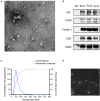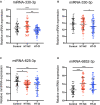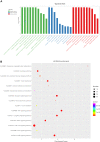Exosomal MicroRNAs Contribute to Cognitive Impairment in Hypertensive Patients by Decreasing Frontal Cerebrovascular Reactivity
- PMID: 33732103
- PMCID: PMC7957933
- DOI: 10.3389/fnins.2021.614220
Exosomal MicroRNAs Contribute to Cognitive Impairment in Hypertensive Patients by Decreasing Frontal Cerebrovascular Reactivity
Abstract
Mechanisms underlying cognitive impairment (CI) in hypertensive patients remain relatively unclear. The present study aimed to explore the relationship among serum exosomal microRNAs (miRNAs), cerebrovascular reactivity (CVR), and cognitive function in hypertensive patients. Seventy-three hypertensive patients with CI (HT-CI), 67 hypertensive patients with normal cognition (HT-NC), and 37 healthy controls underwent identification of exosomal miRNA, multimodal magnetic resonance imaging (MRI) scans, and neuropsychological tests. CVR mapping was investigated based on resting-state functional MRI data. Compared with healthy subjects and HT-NC subjects, HT-CI subjects displayed decreased serum exosomal miRNA-330-3p. The group difference of CVR was mainly found in the left frontal lobe and demonstrated that HT-CI group had a lower CVR than both HT-NC group and control group. Furthermore, both the CVR in the left medial superior frontal gyrus and the miRNA-330-3p level were significantly correlated with executive function (r = -0.275, P = 0.021, and r = -0.246, P = 0.04, respectively) in HT-CI subjects, and the CVR was significantly correlated with the miRNA-330-3p level (r = 0.246, P = 0.040). Notably, path analysis showed that the CVR mediated the association between miRNA-330-3p and executive function. In conclusion, decreased miRNA-330-3p might contribute to CI in hypertensive patients by decreasing frontal CVR and could be a biomarker of early diagnosis.
Keywords: cerebrovascular reactivity; cognitive impairment; exosomal microRNA; hypertension; mediation.
Copyright © 2021 Ma, Cao, Chen, Ye, Qin, Cheng, Zhu and Xu.
Conflict of interest statement
The authors declare that the research was conducted in the absence of any commercial or financial relationships that could be construed as a potential conflict of interest.
Figures







Similar articles
-
Lower Cerebrovascular Reactivity Contributed to White Matter Hyperintensity-Related Cognitive Impairment: A Resting-State Functional MRI Study.J Magn Reson Imaging. 2021 Mar;53(3):703-711. doi: 10.1002/jmri.27376. Epub 2020 Sep 29. J Magn Reson Imaging. 2021. PMID: 32996183
-
Exosomal miRNA-223-3p as potential biomarkers in patients with cerebral small vessel disease cognitive impairment.Ann Transl Med. 2021 Dec;9(24):1781. doi: 10.21037/atm-21-6086. Ann Transl Med. 2021. PMID: 35071475 Free PMC article.
-
Arterial Spin Labeling Imaging Assessment of Cerebrovascular Reactivity in Hypertensive Small Vessel Disease.Front Neurol. 2021 Jun 30;12:640069. doi: 10.3389/fneur.2021.640069. eCollection 2021. Front Neurol. 2021. PMID: 34276531 Free PMC article.
-
Age-related changes in cerebrovascular reactivity and their relationship to cognition: A four-year longitudinal study.Neuroimage. 2018 Jul 1;174:257-262. doi: 10.1016/j.neuroimage.2018.03.033. Epub 2018 Mar 19. Neuroimage. 2018. PMID: 29567504 Free PMC article.
-
Higher Aortic Stiffness Is Related to Lower Cerebral Blood Flow and Preserved Cerebrovascular Reactivity in Older Adults.Circulation. 2018 Oct 30;138(18):1951-1962. doi: 10.1161/CIRCULATIONAHA.118.032410. Circulation. 2018. PMID: 30018169 Free PMC article.
Cited by
-
The interplay of exosomal miRNAs in hypertension and aging.Hypertens Res. 2024 Dec;47(12):3496-3497. doi: 10.1038/s41440-024-01923-0. Epub 2024 Oct 2. Hypertens Res. 2024. PMID: 39358595 No abstract available.
-
Ketogenic diet and microRNAs: focus on cognitive function.Front Nutr. 2025 Feb 17;12:1545832. doi: 10.3389/fnut.2025.1545832. eCollection 2025. Front Nutr. 2025. PMID: 40034740 Free PMC article. Review.
-
Cerebral hemodynamic characteristics of patients with auditory verbal hallucinations and the construction of nomogram models.World J Psychiatry. 2025 Jun 19;15(6):106775. doi: 10.5498/wjp.v15.i6.106775. eCollection 2025 Jun 19. World J Psychiatry. 2025. PMID: 40574762 Free PMC article.
-
Abnormal Cerebrovascular Reactivity and Functional Connectivity Caused by White Matter Hyperintensity Contribute to Cognitive Decline.Front Neurosci. 2022 Mar 4;16:807585. doi: 10.3389/fnins.2022.807585. eCollection 2022. Front Neurosci. 2022. PMID: 35310084 Free PMC article.
References
-
- Fuster J. M. (2001). The prefrontal cortex–an update: time is of the essence. Neuron 30 319–333. - PubMed
LinkOut - more resources
Full Text Sources
Other Literature Sources

